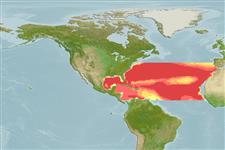>
Beryciformes (Sawbellies) >
Melamphaidae (Bigscale fishes or ridgeheads)
Etymology: Melamphaes: Greek, melan, -anos = black + Greek, amphi = both side (Ref. 45335).
Environment: milieu / climate zone / depth range / distribution range
Ecologia
marino batipelagico; distribuzione batimetrica 50 - 400 m (Ref. 51657), usually 300 - 400 m (Ref. 37108). Deep-water; 40°N - 10°N
Western Atlantic: between 40° and 10°N. Eastern Atlantic: west of 25° or 30°W and one specimen at 24°34'N, 28°04'W.
Length at first maturity / Size / Peso / Age
Maturity: Lm 2.0, range 2 - 2.25 cm
Max length : 2.3 cm SL maschio/sesso non determinato; (Ref. 4502)
Short description
Morfologia | Morfometria
Spine dorsali (totale): 3; Raggi dorsali molli (totale): 14-16; Spine anali 1; Raggi anali molli: 7 - 9; Vertebre: 27 - 28. Head with sharp angle in lateral margin. Preopercle with angle smooth, rounded and slightly emarginate (Ref. 37108).
Life cycle and mating behavior
Maturità | Riproduzione | Deposizione | Uova | Fecundity | Larve
Maul, G.E., 1990. Melamphaidae. p. 612-618. In J.C. Quero, J.C. Hureau, C. Karrer, A. Post and L. Saldanha (eds.) Check-list of the fishes of the eastern tropical Atlantic (CLOFETA). JNICT, Lisbon; SEI, Paris; and UNESCO, Paris. Vol. 2. (Ref. 4502)
IUCN Red List Status (Ref. 130435)
Threat to humans
Harmless
Human uses
Pesca: di nessun interesse
Informazioni ulteriori
Age/SizeAccrescimentoLength-weightLength-lengthLength-frequenciesMorfometriaMorfologiaLarveDinamica popolazioni larvaliReclutamentoAbbondanzaBRUVS
BibliografiaAcquacolturaProfilo di acquacolturaVarietàGeneticaElectrophoresesEreditarietàMalattieElaborazioneNutrientsMass conversion
CollaboratoriImmaginiStamps, Coins Misc.SuoniCiguateraVelocitàModalità di nuotoArea branchialeOtolithsCervelliVista
Strumenti
Special reports
Download XML
Fonti Internet
Estimates based on models
Preferred temperature (Ref.
123201): 10 - 17.3, mean 13.3 °C (based on 32 cells).
Phylogenetic diversity index (Ref.
82804): PD
50 = 0.5000 [Uniqueness, from 0.5 = low to 2.0 = high].
Bayesian length-weight: a=0.01096 (0.00451 - 0.02668), b=3.10 (2.89 - 3.31), in cm total length, based on LWR estimates for this (Sub)family-body shape (Ref.
93245).
Trophic level (Ref.
69278): 3.1 ±0.2 se; based on size and trophs of closest relatives
Resilienza (Ref.
120179): Alto, tempo minimo di raddoppiamento della popolazione meno di 15 mesi (Preliminary K or Fecundity.).
Fishing Vulnerability (Ref.
59153): Low vulnerability (10 of 100).
